TikTok Considers Changes to Distance App From Chinese Roots — Wall Street Journal

–

–
ByteDance Ltd. is considering changing the corporate structure of its popular short-video app TikTok, as it comes under increasing scrutiny in its biggest markets over its Chinese ties.
Senior executives are discussing options such as creating a new management board for TikTok or establishing a headquarters for the app outside of China to distance the app’s operations from China, said a person familiar with the company’s thinking.
TikTok, which has shot to global fame over the last two years thanks to its catchy dancing and lip-syncing videos, is owned by Beijing-based ByteDance, one of the world’s most valuable technology startups. ByteDance, whose secondary shares have valued the firm at $150 billion in recent weeks, counts big-name U.S. investors such as Coatue Management and Sequoia Capital among its backers.
The app has seen a surge in downloads as the coronavirus kept millions of people locked up in their homes and eager for distractions. About 315 million users downloaded TikTok in the first quarter of the year, the most downloads ever for an app in a single quarter, according to research firm Sensor Tower, bringing its total to more than 2.2 billion world-wide.
But as TikTok grows in popularity—and an increasingly assertive Chinese government raises hackles in foreign capitals—regulatory pressure on the app is intensifying.
Officials in several countries have expressed concerns with the large volumes of user data TikTok collects, with some speculating that ByteDance could be compelled to share it with the Chinese government. TikTok has repeatedly denied receiving Chinese government requests for user data and said it wouldn’t respond if asked.
The U.S. State and Defense departments already prohibit employees from downloading TikTok on government devices. On Tuesday, Secretary of State Mike Pompeo hinted at a possible ban for TikTok and other Chinese apps during an interview with Fox News.
In Australia, the chair of a legislative committee looking into foreign interference through social media named TikTok among the platforms that might be called to appear.
“What’s needed is a really clear understanding from the platforms about their approach to privacy and their approach to content moderation. That’s one of the objectives of this inquiry,†Jenny McAllister, the chairwoman of the committee, told an Australian radio station on Monday.
The government in India, one of TikTok’s largest markets, banned the app over cybersecurity concerns following violent clashes along the two countries’ disputed border.
Most recently, TikTok surprised observers by reacting more strongly than Western tech companies to Beijing’s imposition of mainland-style internet controls in Hong Kong.
Where Twitter Inc., TWTR 0.88% Facebook Inc., FB 0.38% and Alphabet Inc.’s Google said they would pause responses to data requests from Hong Kong police, TikTok pulled out of the city entirely—a move some describe as part of the effort to distance the app from China.
“ByteDance is the first of China’s tech giants to make it big outside China, but the company that is the envy of China’s tech world is finding that success has a higher price perhaps than failure,†said Peter Fuhrman, the chairman of investment advisory firm China First Capital.
ByteDance managed to outperform its more established Chinese peers such as Alibaba Group Holding and Tencent Holdings in their quests to go global despite spending less on investments, he added.
ByteDance’s discussions about changing how TikTok is run are still in their early stages, but setting up an independent TikTok management board would allow a degree of autonomy from the parent company, the person familiar with the firm’s thinking said. This person wasn’t aware of any discussions around a corporate spinoff.
TikTok had also been considering opening a new global headquarters as early as December, The Wall Street Journal reported at the time. Singapore, London and Dublin were considered as possible locations. Recent events accelerated such plans, the person said.
TikTok currently doesn’t have a global headquarters. Recently installed Chief Executive Officer Kevin Mayer is based in Los Angeles.
The hiring in May of Mr. Mayer, a longtime Walt Disney Co. executive, put an American face on the Chinese company, whose website lists offices in 11 cities world-wide—none of them in China. The company says it doesn’t allow Chinese moderators to handle TikTok content.
ByteDance nevertheless has a long way to go to convince its critics. Any change to the corporate structure has to be significant enough to separate TikTok from any entanglements with mainland China, and has to cut off mainland Chinese staff from accessing user data, said Fergus Ryan, an analyst at the Australian Strategic Policy Institute. TikTok’s privacy policy says that user data can be accessed by ByteDance and other affiliate companies.
“Will the new structure be designed so as to remove any leverage Beijing can have over it? I find that hard to imagine,†Mr. Ryan said.
–
–





























